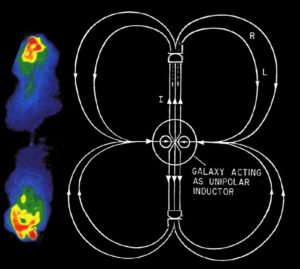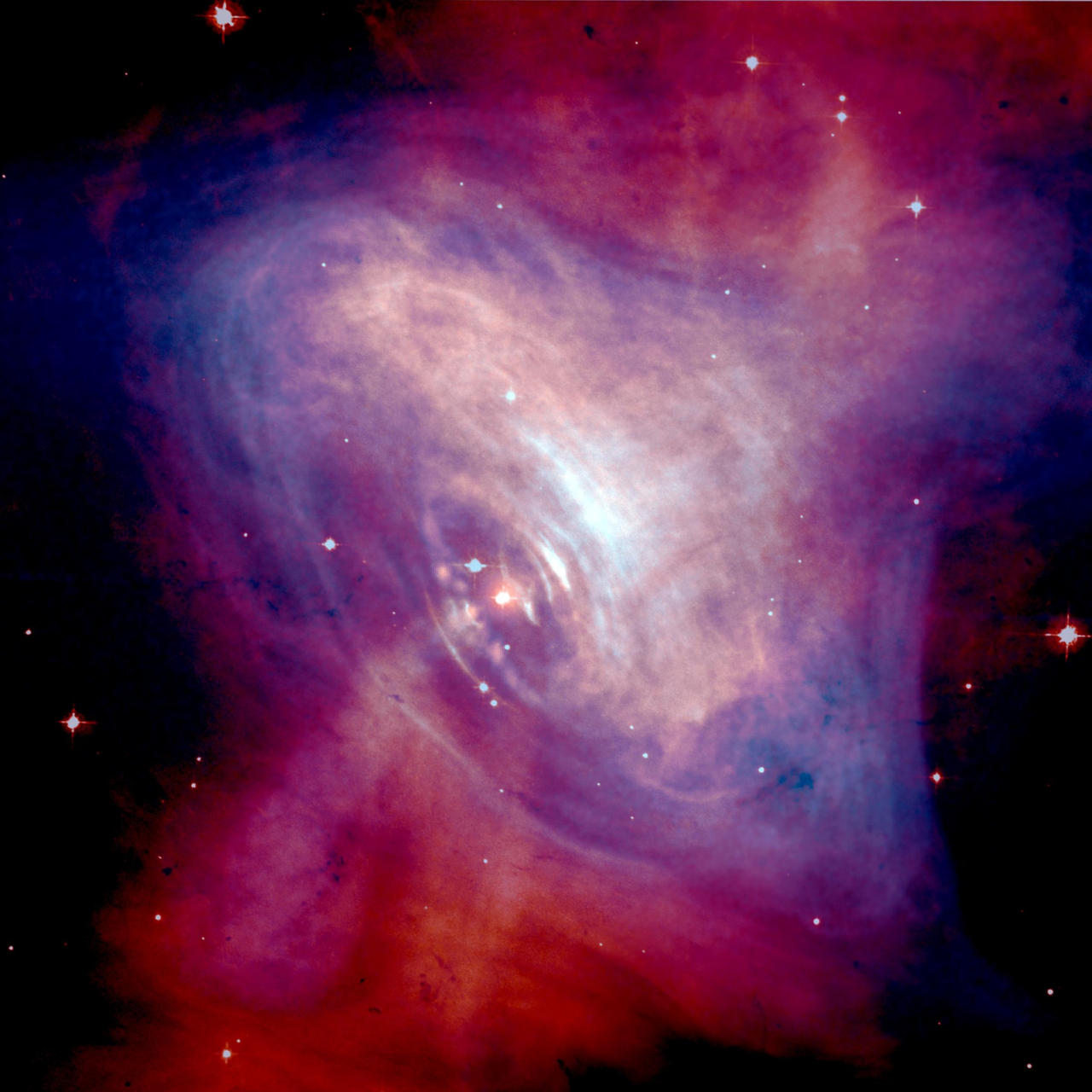A Unipolar inductor usually refers to a device in which a rotating metal disk rotating in a magnetic field, generates an electric current. The metal disk can be any conductor, including a rotating plasma. It is also known as a homopolar generator, unipolar generator, acyclic generator, disk dynamo, or Faraday disk.
Astrophysical unipolar inductors
Unipolar inductors occur in astrophysics where a conductor rotates through a magnetic field, for example, the movement of the highly conductive plasma in a cosmic body’s ionosphere through its magnetic field. In their book, Cosmical Electrodynamics, Hannes Alfvén and Carl-Gunne Fälthammar write:
- “Since cosmical clouds of ionized gas are generally magnetized, their motion produces induced electric fields [..] For example the motion of the magnetized interplanetary plasma produces electric fields that are essential for the production of aurora and magnetic storms” [..]
- “.. the rotation of a conductor in a magnetic field produces an electric field in the system at rest. This phenomenon is well known from laboratory experiments and is usually called ‘homopolar ‘ or ‘unipolar’ induction. [3]
Unipolar inductors have been associated with the aurorae on Uranus,[4] binary stars,[5] [6] black holes,[7] [8] pulsars (neutron stars),[2] galaxies,[9] the Jupiter Io system,[10] [11] the Moon,[12] [13] the Solar Wind,[14] sunspots,[15] [16] in the Venusian magnetic tail.[17], the Earth,[18], and comets.[19] [20]

Notes
- ↑ 2.0 2.1 Ruderman, M. A. & Sutherland, P. G., “Theory of pulsars – Polar caps, sparks, and coherent microwave radiation” FULL TEXT (1975) Astrophysical Journal, vol. 196, Feb. 15, 1975, pt. 1, p. 51-72. PEER REVIEWED
- ↑ Hannes Alfvén, “Keynote Address (1987) Double Layers in Astrophysics, Proceedings of a Workshop held in Huntsville, Ala., 17-19 Mar. 1986. Edited by Alton C. Williams and Tauna W. Moorehead. NASA Conference Publication, #2469″ (Record | Full text) FULL TEXT
- ↑ Hannes Alfvén and Carl-Gunne Fälthammar, Cosmical Electrodynamics (1963) 2nd Edition, Oxford University Press. See sec. 1.3.1. Induced electric field in uniformly moving matter. ACADEMIC BOOK
- ↑ Hill, T. W.; Dessler, A. J.; Rassbach, M. E., “Aurora on Uranus – A Faraday disc dynamo mechanism” (1983) Planetary and Space Science (ISSN 0032-0633), vol. 31, Oct. 1983, p. 1187-1198 PEER REVIEWED
- ↑ Hannes Alfvén, “Sur l’origine de la radiation cosmique” {[full}} (On the origin of cosmic radiation)” Comptes Rendus, 204, pp.1180-1181 (1937) PEER REVIEWED
- ↑ Hakala, Pasi et al, “Spin up in RX J0806+15: the shortest period binary” FULL TEXT (2003) Monthly Notice of the Royal Astronomical Society, Volume 343, Issue 1, pp. L10-L14
- ↑ Burns, M. L.; Lovelace, R. V. E., “Theory of electron-positron showers in double radio sources” FULL TEXT (1982) Astrophysical Journal, Part 1, vol. 262, Nov. 1, 1982, p. 87-99 PEER REVIEWED
- ↑ Shatskii, A. A., “Unipolar Induction of a Magnetized Accretion Disk around a Black Hole“FULL TEXT, (2003) Astronomy Letters, vol. 29, p. 153-157
- ↑ Per Carlqvist, “Cosmic electric currents and the generalized Bennett relation“FULL TEXT (1988) Astrophysics and Space Science (ISSN 0004-640X), vol. 144, no. 1-2, May 1988, p. 73-84. PEER REVIEWED
- ↑ Goldreich, P.; Lynden-Bell, D., “Io, a jovian unipolar inductor“FULL TEXT (1969) Astrophys. J., vol. 156, p. 59-78 (1969) PEER REVIEWED
- ↑ Strobel, Darrell F.; et al, “Hubble Space Telescope Space Telescope Imaging Spectrograph Search for an Atmosphere on Callisto: A Jovian Unipolar Inductor” (2002) The Astrophysical Journal, Volume 581, Issue 1, pp. L51-L54 PEER REVIEWED
- ↑ “Sonett, C. P.; Colburn, D. S., “Establishment of a Lunar Unipolar Generator and Associated Shock and Wake by the Solar Wind” (1967) Nature, vol. 216, 340-343 PEER REVIEWED
- ↑ Schwartz, K.; Sonett, C. P.; Colburn, D. S., “Unipolar Induction in the Moon and a Lunar Limb Shock Mechanism“FULL TEXT in The Moon, Vol. 1, p.7 PEER REVIEWED
- ↑ Srnka, L. J., “Sheath-limited unipolar induction in the solar wind“FULL TEXT (1975) Astrophysics and Space Science, vol. 36, Aug. 1975, p. 177-204 PEER REVIEWED
- ↑ Yang, Hai-Shou, “A force – free field theory of solar flares I. Unipolar sunspots” Chinese Astronomy and Astrophysics, Volume 5, Issue 1, p. 77-83 PEER REVIEWED
- ↑ Osherovich, V. A.; Garcia, H. A., “Electric current in a unipolar sunspot with an untwisted field” (1990) Geophysical Research Letters (ISSN 0094-8276), vol. 17, Nov. 1990, p. 2273-2276 PEER REVIEWED
- ↑ Eroshenko, E. G., “Unipolar induction effects in the Venusian magnetic tail” (1979) Kosmicheskie Issledovaniia, vol. 17, Jan.-Feb. 1979, p. 93-10
- ↑ F J Lowes “The Earth as a unipolar generator” (1978) J. Phys. D: Appl. Phys. 11 765-768 PEER REVIEWED
- ↑ Minami, S.; White, R. S. “An acceleration mechanism for cometary plasma tails” (1986) Geophysical Research Letters (ISSN 0094-8276), vol. 13, Aug. 1986, p. 849-852. PEER REVIEWED
- ↑ Podgornyi, I. M.; Dubinin, E. M.; Israilevich, P. L.; Skolnikova, S. I. “Plasma dynamics in type-1 comet tails” (1984) Komety i Meteory (ISSN 0568-6199), no. 35, 1984, p. 30-34. In Russian PEER REVIEWED
